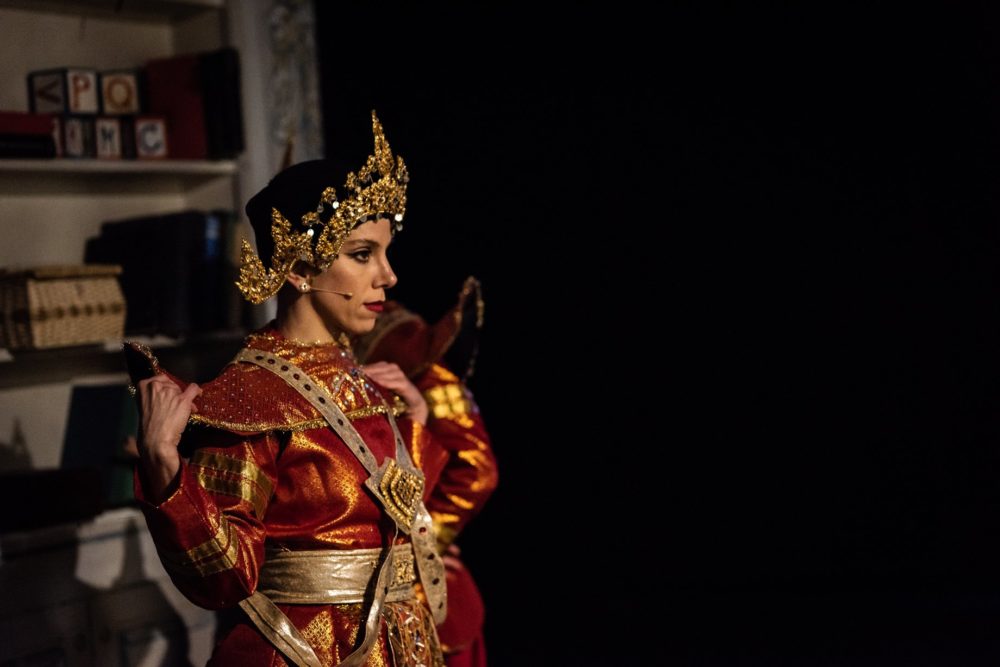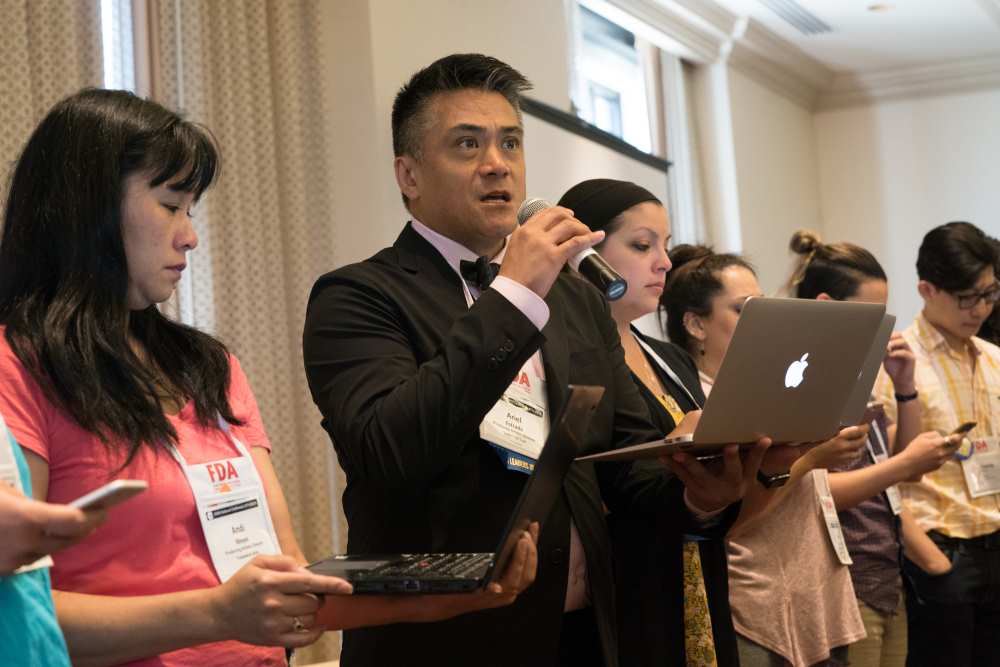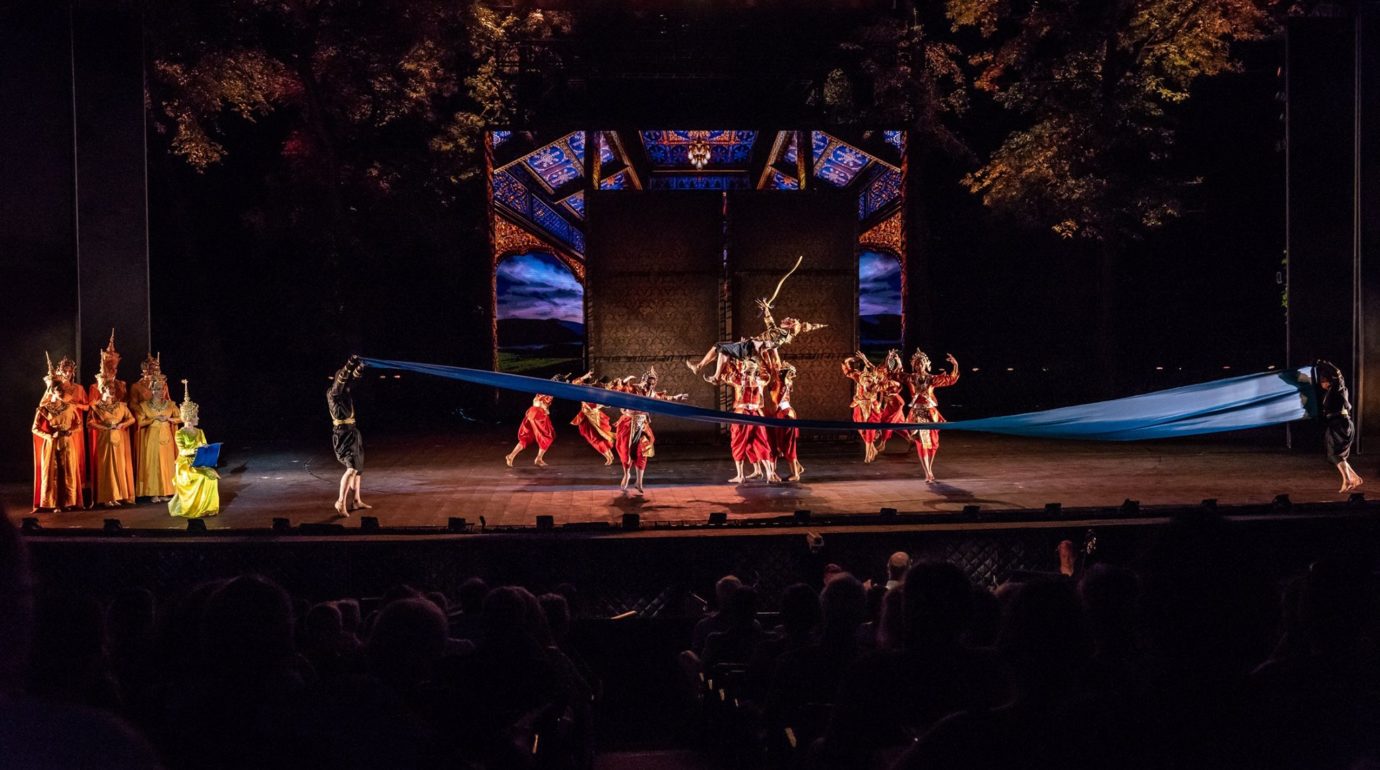Last Friday night I went to the theatre. Which, for a theatre reporter, is a pretty typical Friday night. But this night ended up being anything but typical. I sat down for Jerome Robbins’ Broadway at the Muny, an outdoor theatre in St. Louis that seats around 11,000 people. I and a number of the attendees were in town for Theatre Communications Group’s annual conference (TCG attendees were graciously comped into the performance, in fact). At the opening of the second act of the show, a revue of the legendary choreographer’s greatest hits, I saw a woman in a traditional Thai costume begin to perform a scene from The King and I. The woman was white.
As the performance continued, a group of people started shouting, “Boo yellowface.” Loudly. Repeatedly. It was like watching two shows at once on two different screens. On the left was The King and I; on the right was a protest. As they increased the speed of their shouts, the group rose and left, shouting “boo yellowface” as they exited. Their voices echoed as they left the venue. Meanwhile police were called, but no one was arrested, and the performance continued.
A video of the incident was uploaded onto Facebook and as of press time has received more than 26,000 views. Muny artistic director Mike Isaacson was sitting directly in front of the protesters when they began shouting. In that moment, he told me days later, he felt “anger and horror. I’m still reeling from it, to be honest.”
As news of the protest spread among local media, and then nationally, it has not only raised the specter of yellowface, a racist practice akin to blackface in which white performers play characters of Asian descent. It has also raised the question of the “proper” way to express displeasure when a production or theatre is offensive. The Wall Street Journal’s Terry Teachout (a host on American Theatre’s Three on the Aisle podcast) wrote that he doesn’t believe protesting during a performance is ever appropriate, no matter the rightness of the cause: “To disrupt a public performance of a work of art for any reason whatsoever,” he wrote earlier this week, “is an act of de facto censorship, one not far removed from mob rule.”
For the 15 artists who protested, it wasn’t just the casting of a white actor in an Asian role that was offensive. While that was the reason several members of the Consortium of Asian-American Theatres and Artists came to the show, when they were there they saw other racially and culturally offensive things, which they detailed in a statement: “The MUNY production included drunken sailors cavorting onstage in stereotypical Native American headdresses and plastic Hawaiian hula skirts, as well as non-Latinx actors playing the roles of ‘Puerto Ricans’ in West Side Story.”
Taken together, these moments in the show, the activists said, raised “larger issues about the problematic representations of Asian Pacific Americans and indeed people of color in general. The MUNY and theatres of similar stature are powerful purveyors of culture. They can concoct dehumanized portrayals of people of color and those without agency by upholding and glamorizing, packaged in glitz and glitter with high production values, minstrel performances for consumption by families and children of all ages in their 11,000-seat houses.”

And it wasn’t just Asian-Americans who found the portrayals problematic. Larissa FastHorse, a Native American playwright and performer, wrote an eloquent explanation for why white sailors goofing around in Native American headdresses onstage was offensive. She explained that the feathers in a headdress are each earned by their wearer through acts of bravery and good deeds. A headdress is a treasured personal item that represents “the history of your loved one,” she wrote. “Imagine someone taking that beautiful physical representation and putting it on as a joke and dancing around in it with the intention of making people laugh at the ridiculousness of it. Laugh at your family, your ancestors, you. Now imagine being in a theatre surrounded by thousands of people laughing at that history. Turning your loved one and their life accomplishments into a joke.”
FastHorse isn’t a St. Louis artist, and neither were most of the artists who protested. Like me, they were in town for the TCG conference. But when they heard that there was an instance of cultural appropriation—of white actors wearing Thai clothing and playing Thai characters—onstage in town, they quickly rallied.
“For me it goes beyond the casting,” said Leilani Chan, a conference attendee, CAATA member, and artistic director of Los Angeles-based TeAda Productions. “It’s, why did you select that, and the lens it’s presented in? There’s no contextualization of, ‘this comes from a period of time.’ With our modern eyes, we should be more critical of these stereotypes that are in it.”
Chan added that there were other TCG conference attendees who came to the show and quietly walked out separately, not as part of the organized protest. Others sent letters to the Muny afterward. Kwofe Coleman, the theatre’s marketing director, said that a number of audience members came up to him during the performance to express their concerns about the show. “As theatre professionals and colleagues, I don’t know that the protest is the most effective way to engage in dialogue,” he said. “Those that just tried to engage in dialogue with me I think were successful.”
Isaacson echoed those statements, saying his biggest disappointment wasn’t that audience members didn’t like the show. “Before the event, no one reached out, no one called me, I didn’t get an email, no one knocked on our door saying, ‘Hey, we have a huge problem, can you explain it?’” he said. “It’s shocking and painful to hear that it was from theatre artists who I consider colleagues.”
Chan responded that because Jerome Robbins’ Broadway was finishing up its run (it closed last Sunday, June 17), a private conversation would not have been as productive. “We wanted to spark public awareness and dialogue, which a private conversation would not have done,” she explained. “We want to raise awareness of issues of equity, racism, and representation, in theatre (as well as TV and film) nationwide. This issue seems to keep returning, and we need to draw attention to it nationally so there can be some critical change in our field.”
Isaacson did concede that after the protest, he met with the entire acting company of Jerome Robbins’ Broadway, and many came forward to tell him that they had found certain elements of the show insensitive and hurtful, but did not know how to voice their concerns. “I will forever own the fact that they didn’t knock on my door and say, ‘Hey, can we talk to you,’” he said. “I have to take responsibility for that.”
The Muny has since released a public statement of apology that read, in part, “Our commitment, belief, and dedication to inclusive and diverse casting, as well as honest examination of imagery and ideas in our productions, is real and passionate. Representation matters to the Muny.”

As disruptive and painful as the production and protests have been for all parties involved, those who spoke for this article admitted that it raised questions within the St. Louis community around issues of representation, and suggested ways that predominantly white institutions with predominantly white audiences can better work with communities of color.
“I am grateful for this protest, because otherwise I may never have known about the issue,” said Anna Skidis Vargas, the artistic director of St. Louis’s Theatre Nuevo. She added that “race-related protests are not new to this city,” noting that in 2016, 40 Black Lives Matter activists protested during a performance of Aida at the Muny, stopping the show. “This most recent protest had the added benefit of having taken place during a national conference where more than St. Louis was watching,” she said.
Now that most of the artists who participated in the protest have left town, and the Muny is currently mounting its next show (The Wiz, with an all-black cast and people of color on the creative team), it is up to St. Louis artists to decide what comes next. Ron Himes is the artistic director of the city’s Black Repertory Company, which serves a smaller and more diverse audience than the Muny. He admitted that while the Muny has supported his theatre financially over the years, there is still education that needs to happen, and he hopes that a broader conversation can arise from these events.
“It’s not something that just the Muny has done, or made a mistake in terms of producing,” he remarked. “I think they can learn some sensitivity, they can learn about the importance of being inclusive. They can hopefully learn that they serve a broader audience and a broader community than they used to, and that community and that audience is changing, has changed, will continue to change, and they have to be sensitive to that.”
Andi Meyer, who is based in the nearby Kansas City with the company Tradewind Arts, said that she is hoping for better representation of people of color on the Muny stage—and hopefully works by people of color.
“I hope they never do anything like this again,” she said. “I hope they really take it seriously that if they’re going to be packing their house with 11,000 per show, they have a large responsibility to the city of St. Louis, Missouri, and the Midwest, and the whole nation, to be leaders.”


